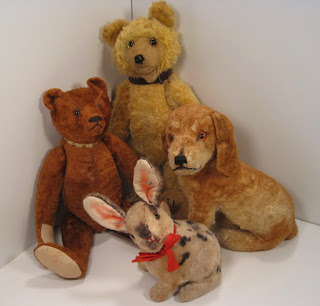Oh baby! Steiff enthusiasts are certain to recognize this beloved pattern as that of Teddy baby. This version is about 17 cm tall, standing, fully jointed and made from chocolate brown mohair. His paw pads are made from tan felt. He has all the legacy Teddy baby features, including flat, cardboard lined feet designed for standing; downward curving paws; a prominent muzzle; and a delightful, childlike appearance. However, unlike most prewar Teddy baby bears 15 cm tall and larger, this one has a closed mouth - making him quite the rare bear indeed!
Let's give a shout out to this pensive pattern. Just for comparison, consider the following history. Steiff's beloved, open mouthed brown mohair Teddy babies were made prewar in 13 sizes ranging from 9 to 65 cm from 1930 - 1943 overall. Given the number of years and sizes produced, these appear with somewhat regularity on the secondary market. However, Steiff manufactured its brown mohair closed mouthed Teddy babies only in six sizes ranging from 15 to 45 cm from 1929 - 1931 overall. So simply based on the numbers, finding a Steiff prewar, closed mouth Teddy baby is sort of like hitting the lottery! Here on the left you can see three Steiff brown Teddy baby bears: the one on the left is the closed mouth version under discussion today, the one in the middle is an open mouthed version from the 1950s, and the one on the right is an open mouthed version from the 1930s.
It's always fun, and interesting, to think about why a pattern was produced for only a handful of years. Clearly, the closed mouth version was introduced with optimism, as shown in this leaflet from October, 1929. The picture is from Carsten Esser's Steiff Katalog 1920-1929. Although there is nothing exactly documented (at least that Steiffgal can find) about why the closed mouth pattern was discontinued so quickly, here are three possible reasons why.
The first, from the business/financial perspective, is that the open mouth version simply sold much better than the closed mouth version. Although the two are similar, the open mouth version appears sweeter and kinder than the closed mouth, more "pouty" version. This may have called to consumers' preferences, and pocketbooks, and the company simply "fished where the fish are."
The second, from the product development perspective, is that the open mouthed version might have better reflected the company's design priorities than did the closed mouth version. The general Teddy baby pattern was invented due to a late 1920's directive of Richard Steiff. He asked that the company develop products with "smiling faces that come alive." It is pretty clear that the open mouthed version is more "smile-ly" than the closed mouth version.
The third is a bit more esoteric. From the historical and public relations perspectives, it is possible that the open mouth version might have projected a kinder, more welcoming face for the company than did the more solemn, closed mouth version. This is important when you consider what was happening in Germany and the world at the time that the pattern launched. Germany entered a period of economic depression and widespread unemployment in 1929 while growing anti-German sentiment were starting to cripple Steiff's export markets. As such, the happy-go-lucky open mouthed Teddy baby was the perfect, joyful fit as the company's brand ambassador at a most challenging time.
Steiffgal hopes this discussion on closed mouth Teddy baby bears has opened up new ways of thinking for you about this delightful legacy pattern.
Have a question about one of your Steiff treasures? Let's talk! Click here to learn more.























